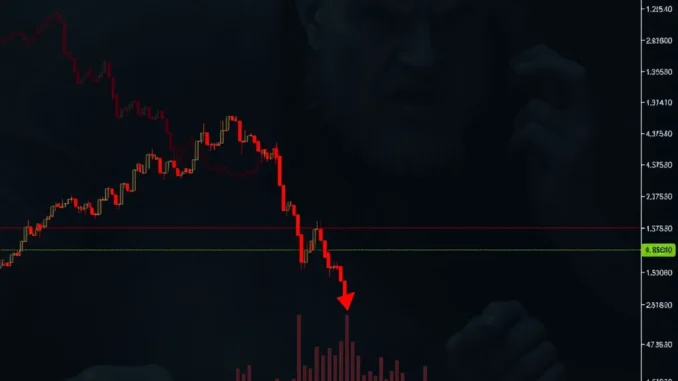
Is the Bitcoin market feeling the heat? Recent on-chain analysis points to a concerning trend: continuous Bitcoin selling pressure originating from short-term holders. Let’s dive into what’s causing this and what it means for the crypto king.
What’s Fueling the Relentless Bitcoin Selling Pressure?
According to Glassnode, a leading on-chain analysis firm, the current market climate is characterized by persistent Bitcoin selling pressure. This isn’t just your typical market fluctuation; it’s a sustained trend driven by specific factors. But what exactly is behind this pressure?
- Increased Volatility: The crypto market is known for its ups and downs, but recent volatility seems to be shaking the confidence of newer investors. This heightened uncertainty is prompting many short-term holders to exit their positions.
- Weak Demand: For any asset to thrive, buying interest is crucial. Currently, the demand side appears to be sluggish. Meaningful buying volume hasn’t returned to the market, indicating a lack of fresh capital flowing into Bitcoin.
- Reduced Liquidity: Liquidity refers to how easily an asset can be bought or sold without significantly affecting its price. Lower liquidity can exacerbate price swings and create a more fragile market environment. In Bitcoin’s case, reduced liquidity amplifies the impact of selling pressure.
These factors combined paint a picture of a market where downside risks are escalating. But how do we actually measure this selling pressure?
Short-Term Holders and the SOPR Indicator: Decoding Market Panic
To understand the behavior of short-term holders, analysts often look at the Spent Output Profit Ratio (SOPR) indicator. Think of SOPR as a gauge of market sentiment, specifically showing whether investors are selling at a profit or a loss. Here’s a simple breakdown:
| SOPR Value | Interpretation |
|---|---|
| Above 1 | Holders are, on average, selling at a profit. |
| Below 1 | Holders are, on average, selling at a loss. |
| Around 1 | Break-even point – holders are selling around their purchase price. |
Glassnode highlights that the SOPR for short-term holders has plummeted below 1. This is a significant signal. It suggests that these holders, often more sensitive to market fluctuations, are currently selling at a loss. Why?
The analysis points to market panic. When the SOPR drops below 1, it indicates that short-term holders are not confident in a quick price rebound. Instead of holding on and hoping for profits, fear takes over, driving them to cut their losses and exit the market. This loss-cutting behavior further intensifies the selling pressure on Bitcoin.
Why is On-Chain Analysis Crucial for Understanding Bitcoin Market Dynamics?
In the traditional financial world, investors often rely on company reports and macroeconomic indicators. But in the crypto space, especially for a transparent blockchain like Bitcoin, on-chain analysis provides a unique lens. It allows us to directly examine transaction data, wallet activity, and holder behavior on the blockchain itself. This granular level of insight is invaluable for understanding market dynamics. Here’s why it matters:
- Transparency: Blockchain data is public and immutable. This transparency enables objective analysis of market activity, free from the biases of traditional reporting.
- Real-Time Insights: On-chain metrics provide near real-time data on market movements, allowing for quicker identification of trends and potential shifts in sentiment.
- Understanding Holder Behavior: Metrics like SOPR and analysis of different holder cohorts (short-term vs. long-term) offer direct insights into how various market participants are reacting to price changes.
- Identifying Market Stress: On-chain analysis can help pinpoint periods of market stress, like the current selling pressure, by observing patterns in transaction volumes, profitability, and holder behavior.
Navigating Bitcoin’s Volatile Waters: What Could Be Next?
The ongoing market volatility and selling pressure raise important questions about Bitcoin’s near-term trajectory. What can we expect moving forward? While predicting the future is impossible, understanding the current dynamics helps us consider potential scenarios:
- Continued Downside Risk: If the factors driving selling pressure persist – volatility, weak demand, and low liquidity – the downside risk for Bitcoin remains elevated. Further price corrections are possible.
- Potential for Capitulation: If the market panic intensifies and more short-term holders capitulate (sell at a loss), we could see a sharp price drop. However, capitulation events can sometimes mark the bottom of market cycles.
- Need for Demand Revival: For Bitcoin to break free from this selling pressure and initiate a sustainable recovery, a significant increase in demand is essential. This could come from institutional investors, renewed retail interest, or positive macroeconomic developments.
- Monitoring Key Metrics: Keeping a close watch on on-chain metrics like SOPR, exchange flows, and active addresses will be crucial for gauging market sentiment and identifying potential turning points.
Demand and Liquidity: The Keys to Bitcoin’s Rebound?
Ultimately, overcoming the current Bitcoin selling pressure hinges on the return of robust demand and improved liquidity. These are the missing pieces in the puzzle. Here’s why they are so vital:
- Demand Absorbs Selling Pressure: Strong buying demand can effectively absorb selling pressure, preventing further price declines and setting the stage for upward momentum.
- Liquidity Facilitates Trading: Higher liquidity makes it easier for buyers and sellers to transact without causing significant price slippage. This creates a more stable and attractive market environment.
- Confidence Booster: Increased demand and liquidity often signal renewed market confidence. This can attract more investors and break the cycle of fear and selling pressure.
In conclusion, Bitcoin is currently navigating a challenging period marked by persistent selling pressure from short-term holders. Market panic, fueled by volatility and weak demand, is driving loss-cutting behavior, as reflected in the concerning SOPR indicator. While the situation presents downside risks, the crypto market is known for its resilience. The key to recovery lies in the resurgence of demand and the restoration of liquidity. Keeping a close eye on on-chain metrics and market sentiment will be crucial in the coming weeks to understand if and when this selling pressure will subside.



